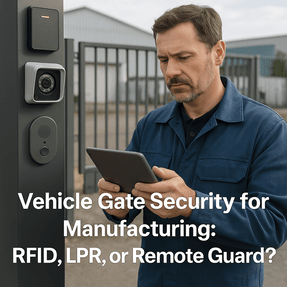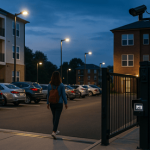
Managing who—and what—comes through your facility gate is more complex than it used to be. For manufacturers, the vehicle gate isn’t just the start of your perimeter—it’s the first line of defense for your people, property, and operations.
If you’re exploring how to secure entry points at your manufacturing plant, three options likely come up:
✅ RFID vehicle access
✅ License Plate Recognition (LPR)
✅ Remote guard services
Each offers unique advantages. But what’s often overlooked is how they can work even better together—forming a layered, responsive vehicle access control system tailored to the specific risks of an industrial environment.
Let’s break down how each works, where they shine, and why a combination might be the most secure and scalable option for your facility.
k
k
RFID: Fast, Trusted Entry for Authorized Vehicles
What it is:
RFID (Radio Frequency Identification) uses radio waves to allow tagged vehicles to pass through gate readers without manual intervention. Tags can be windshield-mounted, embedded in fleet vehicles, or issued on access cards.
Where RFID excels:
-
Speed: High-volume, repeat access (like employees or delivery trucks) can pass through quickly without stopping.
-
Accountability: Access is tied to a specific badge or vehicle tag, giving you clear records of who entered and when.
-
Control: RFID systems are tightly integrated with access control software, so you can set permissions by role, schedule, or zone.
Use case:
A manufacturing facility with dozens of employee and fleet vehicle entries per day uses RFID to speed up morning access while logging every vehicle event in its security database.
Limitations:
-
Doesn’t always capture visual verification
-
Vulnerable to badge sharing if not paired with driver ID or camera
k
k
LPR: License Plate Recognition for Visual Validation
What it is:
LPR cameras automatically read and log license plates as vehicles approach your gate. Systems can compare plates against allowlists, denylists, or flag unexpected activity.
Where LPR shines:
-
Non-credentialed access: Great for vendors, contractors, or one-time visitors where issuing RFID credentials isn’t practical.
-
Surveillance integration: When paired with video management software, LPR footage can support investigations or claims.
-
Event linking: You get time-stamped images tied to access logs—useful for audits or reviewing past activity.
Use case:
A distribution center uses LPR to verify third-party carrier vehicles and logs plate numbers for compliance and incident tracking.
Limitations:
-
Not foolproof in poor weather or with dirty/damaged plates
-
Doesn’t confirm who is driving
k
k
Remote Guard: Human Oversight Without Full-Time Staffing
What it is:
A remote video guard service uses live surveillance to verify and manage vehicle access. When a car pulls up, a remote operator can speak through intercom, verify ID via camera, and unlock the gate if authorized.
Where remote guards are best:
-
After-hours access: Keeps gates monitored without paying for on-site guards 24/7.
-
Unexpected events: If a vendor shows up unannounced or a gate malfunctions, a remote operator can intervene in real time.
-
Human judgment: Unlike automated systems, remote guards can spot suspicious behavior or resolve gray-area situations.
Use case:
An industrial plant uses remote guards overnight to verify late deliveries and prevent unauthorized entry during unstaffed shifts.
Limitations:
-
Response time can vary depending on monitoring provider
-
Requires reliable surveillance infrastructure and network uptime
k
k
So… Which One Is Right for You?
That depends on your operation’s needs:
| Facility Type | Best Fit Solution |
|---|---|
| High-volume employee access | RFID |
| Frequent vendor/contractor traffic | LPR |
| Unstaffed entry gates | Remote Guard |
| High-security zones or CTPAT facilities | All three, integrated |
k
k
Why These Work Even Better Together
Individually, these technologies each solve a piece of the puzzle. But in manufacturing environments—where security, safety, and operations intersect—the real power is in combining them.
Example: A Layered Approach
-
RFID grants quick access to fleet vehicles or staff
-
LPR verifies every vehicle plate and flags unknowns
-
Remote Guard steps in to review or verify exceptions in real time
All of this can feed into your access control software and camera system, giving your team:
-
Real-time visibility
-
Audit trails for every gate event
-
Faster decision-making during emergencies or incidents
k
k
Final Thoughts: Don’t Let the Gate Be a Weak Link
Manufacturing facilities face unique perimeter risks—vehicle theft, tailgating, unauthorized deliveries, even insider threats. Securing your vehicle gate isn’t just about keeping people out. It’s about knowing who’s in, who should be in, and who shouldn’t—with a system smart enough to respond automatically and flexibly.
At SSP, we design and deploy custom vehicle gate security systems that combine RFID, LPR, and remote guard services—integrated into a single, streamlined interface for your team.
Want to modernize your gate security?
Let’s start with a conversation. Contact SSP today.


